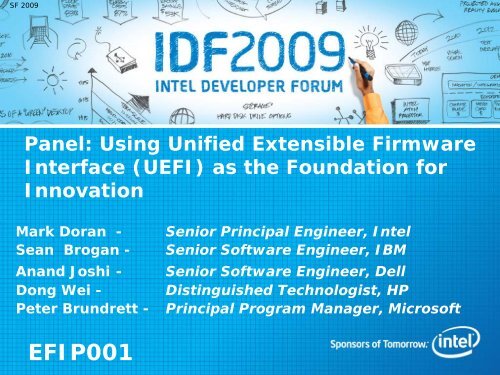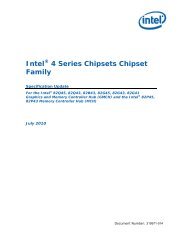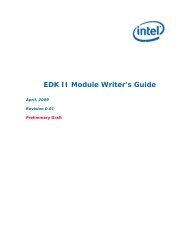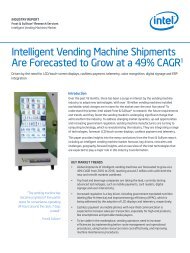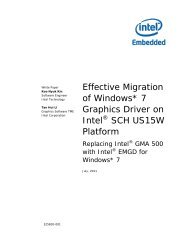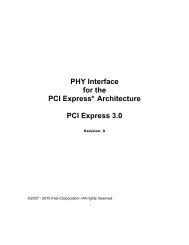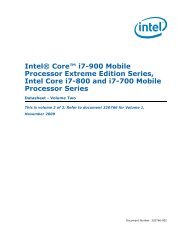Using Unified Extensible Firmware Interface (UEFI) as the ... - Intel
Using Unified Extensible Firmware Interface (UEFI) as the ... - Intel
Using Unified Extensible Firmware Interface (UEFI) as the ... - Intel
You also want an ePaper? Increase the reach of your titles
YUMPU automatically turns print PDFs into web optimized ePapers that Google loves.
SF 2009<br />
Panel: <strong>Using</strong> <strong>Unified</strong> <strong>Extensible</strong> <strong>Firmware</strong><br />
<strong>Interface</strong> (<strong>UEFI</strong>) <strong>as</strong> <strong>the</strong> Foundation for<br />
Innovation<br />
Mark Doran -<br />
Sean Brogan -<br />
Anand Joshi -<br />
Dong Wei -<br />
Peter Brundrett -<br />
Senior Principal Engineer, <strong>Intel</strong><br />
Senior Software Engineer, IBM<br />
Senior Software Engineer, Dell<br />
Distinguished Technologist, HP<br />
Principal Program Manager, Microsoft<br />
EFIP001
Agenda<br />
•<strong>UEFI</strong> Technical Specifications updates<br />
•<strong>Using</strong> <strong>UEFI</strong> <strong>as</strong> an enabling foundation for<br />
platform innovation<br />
•Industry leaders discussing how <strong>UEFI</strong> is<br />
helping <strong>the</strong>m innovate and differentiate<br />
<strong>the</strong>ir products<br />
2
Agenda<br />
•<strong>UEFI</strong> Technical Specifications updates<br />
•<strong>Using</strong> <strong>UEFI</strong> <strong>as</strong> an enabling foundation for<br />
platform innovation<br />
•Industry leaders discussing how <strong>UEFI</strong> is<br />
helping <strong>the</strong>m innovate and differentiate<br />
<strong>the</strong>ir products<br />
3
Standard <strong>Firmware</strong> <strong>Interface</strong>s<br />
<strong>UEFI</strong><br />
Platform Initialization<br />
<strong>UEFI</strong>enabled<br />
OS<br />
DXE Driver<br />
PI<br />
<strong>UEFI</strong> Driver<br />
<strong>UEFI</strong><br />
Shell<br />
• • •<br />
CPU PEI<br />
Modules<br />
<strong>UEFI</strong> Driver<br />
<strong>UEFI</strong> Driver<br />
Hardware<br />
Option<br />
ROMs<br />
BDS<br />
Compatibility<br />
Support<br />
Module<br />
C/S PEI<br />
Modules<br />
Legacy<br />
OS<br />
Modular components<br />
• <strong>UEFI</strong>: <strong>Unified</strong> <strong>Extensible</strong><br />
<strong>Firmware</strong> <strong>Interface</strong><br />
– a new model for <strong>the</strong><br />
interface between <strong>the</strong> OS<br />
and platform firmware<br />
• PI: Platform Initialization<br />
– Standardization: key to<br />
interoperability across<br />
implementations<br />
– Modular components like<br />
silicon drivers (e.g. PCI)<br />
and value-add drivers<br />
(security)<br />
– Preferred way to build <strong>UEFI</strong><br />
<strong>UEFI</strong> is Architected for Dynamic<br />
Modularity<br />
4
Latest <strong>UEFI</strong> Specifications<br />
<strong>UEFI</strong><br />
Platform Initialization<br />
<strong>UEFI</strong>enabled<br />
OS<br />
DXE Driver<br />
PI<br />
<strong>UEFI</strong> Driver<br />
<strong>UEFI</strong><br />
Shell<br />
• • •<br />
CPU PEI<br />
Modules<br />
<strong>UEFI</strong> Driver<br />
<strong>UEFI</strong> Driver<br />
Hardware<br />
Option<br />
ROMs<br />
BDS<br />
Compatibility<br />
Support<br />
Module<br />
C/S PEI<br />
Modules<br />
Legacy<br />
OS<br />
Modular components<br />
•Platform Initialization<br />
(PI) 1.2 Spec<br />
•Packaging 1.0 Spec<br />
•<strong>UEFI</strong> 2.3 Spec<br />
•Self Certification Tests<br />
(SCT) for <strong>UEFI</strong> 2.1<br />
Spec<br />
•Shell 2.0 Spec<br />
Advancements in firmware technologies continue<br />
to evolve. Join <strong>the</strong> <strong>UEFI</strong> forum www.<strong>UEFI</strong>.org<br />
5
<strong>UEFI</strong> Specification Timeline<br />
Specifications<br />
<strong>UEFI</strong> 2.0<br />
PI 1.0<br />
<strong>UEFI</strong> 2.1<br />
http://uefi.org<br />
PI 1.1<br />
<strong>UEFI</strong> 2.2<br />
Shell 2.0<br />
<strong>UEFI</strong> 2.3<br />
PI 1.2<br />
Packaging 1.0<br />
2006<br />
2007<br />
2008<br />
2009<br />
2010<br />
Implementation<br />
SCT <strong>UEFI</strong><br />
2.0<br />
EDK 1.01:<br />
<strong>UEFI</strong> 2.0<br />
SCT<br />
PI 1.0<br />
EDK 1.04:<br />
<strong>UEFI</strong> 2.1<br />
PI 1.0<br />
Open Source<br />
SCT <strong>UEFI</strong><br />
2.1<br />
EDK 1.05:<br />
<strong>UEFI</strong> 2.1+<br />
PI 1.0<br />
EDK II:<br />
<strong>UEFI</strong> 2.1+<br />
PI 1.0<br />
Upcoming<br />
EDK II:<br />
<strong>UEFI</strong> 2.3+<br />
PI 1.1+<br />
Leg<br />
All products, dates, and programs are b<strong>as</strong>ed on current expectations and subject to change without notice.<br />
6
Agenda<br />
•<strong>UEFI</strong> Technical Specifications updates<br />
•<strong>Using</strong> <strong>UEFI</strong> <strong>as</strong> an enabling foundation for<br />
platform innovation<br />
•Industry leaders discussing how <strong>UEFI</strong> is<br />
helping <strong>the</strong>m innovate and differentiate<br />
<strong>the</strong>ir products<br />
7
Utilize <strong>UEFI</strong> Full Potential<br />
Good for Internal<br />
Development<br />
Needed for<br />
ISVs/End users<br />
Legacy BIOS<br />
<strong>UEFI</strong> Switch -<br />
CSM & <strong>UEFI</strong> I/F<br />
<strong>UEFI</strong> CSM 1 only<br />
Cl<strong>as</strong>s 0 Cl<strong>as</strong>s 1<br />
<strong>UEFI</strong> Pure I/F<br />
Cl<strong>as</strong>s 2 Cl<strong>as</strong>s 3<br />
Limited Benefits:<br />
OEMs/ODMs internal<br />
Development Optimization<br />
& Code Modularity<br />
Full Benefits:<br />
<strong>UEFI</strong> Innovation<br />
Performance<br />
Extensibility<br />
Advanced Usability<br />
Build <strong>UEFI</strong> Cl<strong>as</strong>s 2/3 <strong>UEFI</strong> Systems!<br />
8<br />
1<br />
Compatibility Support Module – Legacy BIOS interface on top of <strong>UEFI</strong>
<strong>UEFI</strong> Enabling Platform Innovation<br />
Modern <strong>Firmware</strong> for Modern IT<br />
E<strong>as</strong>ier to configure<br />
and deploy<br />
Makes Computers<br />
more manageable<br />
• Richer configuration (allows for more adapters)<br />
• Graphic User <strong>Interface</strong> in Pre-boot environment<br />
• Remote upgrade capability of specific firmware components<br />
• Solves out of-<strong>the</strong>-box configuration & provisioning issues<br />
• Creates a common infr<strong>as</strong>tructure for managing all machines<br />
• Enable secure automated management – lower risks of<br />
“Rogue” servers or clients on <strong>the</strong> network<br />
Network Scalable<br />
and Secure<br />
<strong>Firmware</strong><br />
• Enhanced networking APIs in <strong>the</strong> pre-boot network stack<br />
• Richer network au<strong>the</strong>ntication (log-on)<br />
• <strong>UEFI</strong> Certificate Authority for interoperable trust<br />
Breaks through<br />
BIOS barriers<br />
• Free from architectural limitation - scales technology across<br />
all platforms (Server, Desktop, Mobile, and Handheld)<br />
• Access to disk range beyond 2TB – utilization of resources<br />
• Option Rom Decongestion<br />
9
Agenda<br />
•<strong>UEFI</strong> Technical Specifications updates<br />
•<strong>Using</strong> <strong>UEFI</strong> <strong>as</strong> an enabling foundation for<br />
platform innovation<br />
•Industry leaders discussing how <strong>UEFI</strong> is<br />
helping <strong>the</strong>m innovate and differentiate<br />
<strong>the</strong>ir products<br />
10
<strong>UEFI</strong> Adoption<br />
<strong>UEFI</strong> Technology is <strong>the</strong> primary<br />
firmware reference of choice for<br />
<strong>Intel</strong>® Xeon® 5500 Processor<br />
b<strong>as</strong>ed Platforms<br />
Growing <strong>UEFI</strong> Community<br />
Major MNCs shipping <strong>UEFI</strong><br />
Source: <strong>UEFI</strong> Forum Media Advisory For Spring’08<br />
11
<strong>Intel</strong> Developer Forum | September 2009<br />
IBM Innovations using:<br />
<strong>Unified</strong> <strong>Extensible</strong> <strong>Firmware</strong> <strong>Interface</strong> (<strong>UEFI</strong>) &<br />
Platform Initialization (PI)<br />
Sean Brogan -<br />
Senior Software Engineer,<br />
IBM Systems and Technology Group<br />
© 2009 IBM Corporation
Modular and Blade Systems | <strong>Intel</strong> Developer Forum - September 2009<br />
System X Servers<br />
• Comprehensive transition of <strong>the</strong> System x portfolio to <strong>UEFI</strong> b<strong>as</strong>ed firmware<br />
• <strong>UEFI</strong> 2.1 PI 1.0 specification compliant<br />
• Improved management and configuration capabilities<br />
• Advanced “Touchless” Compatibility Support Module (CSM)<br />
• Trusted Platform features: TPM enablement, TCG and Core Root for Me<strong>as</strong>urement support<br />
Blade<br />
Rack-mount<br />
Tower<br />
Large-scale<br />
• HS22<br />
• x3650 M2<br />
• x3550 M2<br />
• X3250 M3<br />
• x3500 M2<br />
• x3400 M2<br />
• x3200 M3<br />
• dx360 M2*<br />
13<br />
* System does not support Trusted Platform features<br />
© 2009 IBM Corporation
Modular and Blade Systems | <strong>Intel</strong> Developer Forum - September 2009<br />
Advancing <strong>the</strong> platform<br />
• Complete <strong>UEFI</strong> 2.1 / PI 1.0 firmware implementation (Power on to boot selection)<br />
• Strong/Modular framework<br />
– Global Development (4+ time zones)<br />
– Interoperability with Internal teams, partners, and vendors<br />
– Allowing feature b<strong>as</strong>ed development<br />
– Common code b<strong>as</strong>e<br />
• Seamlessly support legacy environment<br />
– IBM Surepath CSM (Legacy x86 BIOS support for legacy OS support)<br />
– Touchless CSM invocation - auto detection of boot option(<strong>UEFI</strong>/legacy)<br />
– <strong>UEFI</strong> Cl<strong>as</strong>s 2 – supporting both <strong>UEFI</strong> boot and legacy boot Operating Systems<br />
• Standardized Pre-boot Security<br />
– TPM 1 hardware enablement<br />
– TCG 2 and Core Root of Trust for Me<strong>as</strong>urement support (CRTM)<br />
– Secure Update methods<br />
– Attend IDF Session EFIS001 for more details<br />
– IBM/<strong>Intel</strong> collaborative Whitepaper “Trusted Platforms: <strong>UEFI</strong>,PI and TCG-b<strong>as</strong>ed firmware”<br />
14<br />
1<br />
TPM: Trusted Platform Module<br />
2<br />
TCG: Trusted Computing Group<br />
© 2009 IBM Corporation
Modular and Blade Systems | <strong>Intel</strong> Developer Forum - September 2009<br />
Future are<strong>as</strong> of investigation<br />
• IBM Enterprise system support<br />
• EDKII development environment<br />
• Specification Evolution (<strong>UEFI</strong> 2.2+ and PI 1.1+)<br />
– IPV6<br />
– <strong>UEFI</strong> certificate authority with driver and module signing<br />
– Out of Band management capabilities<br />
<strong>UEFI</strong> provides a great foundation for innovation!<br />
15<br />
© 2009 IBM Corporation
<strong>UEFI</strong> AND DELL<br />
Anand Joshi<br />
Sr. Software Development Engineer, Dell
<strong>UEFI</strong> VALUE PROPOSITION<br />
BIOS Core<br />
Dell Feature<br />
Feature Module<br />
Module<br />
Silicon<br />
Silicon<br />
Supplier<br />
Supplier<br />
Open<br />
Open<br />
source<br />
source<br />
Module<br />
Module<br />
3 rd party<br />
3 rd supplied<br />
party<br />
supplied<br />
code<br />
code<br />
• <strong>UEFI</strong> defines a standard software “bus”<br />
• Plug-in modules from different suppliers can co-exist<br />
– Silicon suppliers<br />
– Open Source<br />
– Dell IP<br />
– 3 rd party<br />
• Creates an attractive, standardized market for 3 rd party firmware component suppliers<br />
• Enables code development/collaboration with Dell’s partner's<br />
17
<strong>UEFI</strong> On Dell Servers<br />
Dell PowerEdge servers b<strong>as</strong>ed on <strong>Intel</strong> Series 5500 processor<br />
feature <strong>UEFI</strong> 2.1<br />
Modula:<br />
M610<br />
M710<br />
Rack<br />
R410<br />
R610<br />
R710<br />
Tower<br />
T310<br />
T410<br />
T610<br />
T710<br />
18
INNOVATION<br />
• Enhanced pre-boot<br />
space<br />
– Improved Graphical User<br />
<strong>Interface</strong><br />
– Network support<br />
– USB hot plug<br />
•Better manageability<br />
– Common configuration<br />
<strong>Interface</strong> through HII<br />
– <strong>Intel</strong>ligent, Efficient<br />
Platform Updates<br />
– Flexible OS deployment<br />
19
HP <strong>UEFI</strong> Status<br />
Dong Wei<br />
Distinguished Technologist<br />
<strong>UEFI</strong> Board Member (HP)<br />
© 2009 Hewlett-Packard Development Company, L.P.<br />
The information contained herein is subject to change without notice
HP <strong>UEFI</strong> Support Status<br />
• HP Printers/Scanners<br />
− Color Multifunction Printer (shipped)<br />
− ScanJet Enterprise 7000n/nx Document Capture Workstation<br />
(to be shipped)<br />
• HP Notebooks and Tablet PCs<br />
− HP innovating b<strong>as</strong>ed on <strong>the</strong> <strong>UEFI</strong> technology: e.g., Diag<br />
− Commercial systems support <strong>UEFI</strong> boot<br />
• HP Desktops and Workstations<br />
− Adopt a common <strong>UEFI</strong> codeb<strong>as</strong>e<br />
− Collaborate with Commercial Notebooks on HP features that<br />
provide enhanced manageability, security and e<strong>as</strong>e of use<br />
• HP Integrity Business Critical Servers<br />
− HP-UX, Windows, Linux, OpenVMS, HP Integrity Virtual<br />
Machine operating environments use <strong>UEFI</strong><br />
• HP StorageWorks<br />
− <strong>Using</strong> <strong>UEFI</strong> to deliver next generation storage arrays<br />
• <strong>UEFI</strong>/PI framework h<strong>as</strong> enabled code sharing<br />
opportunities among business entities and with<br />
partners/vendors.<br />
21<br />
Hewlett-Packard Company makes no warranty <strong>as</strong> to <strong>the</strong> accuracy or completeness of <strong>the</strong> foregoing material<br />
and hereby disclaims any responsibility <strong>the</strong>refor.
Innovations<br />
• Enhanced Diagnostics<br />
− DIMM fault isolation<br />
− Hard drive simultaneous test<br />
− Concurrent memory, hard drive and batteries test<br />
− Improve test coverage, optimize test cycles<br />
• Cost Savings<br />
• Shift resources towards differentiation and innovation<br />
• Reuse common modules across product segments<br />
• Converged EDK strategy would enable f<strong>as</strong>ter and wider industry<br />
adoption, removes unnecessary w<strong>as</strong>te in resources porting across<br />
codeb<strong>as</strong>es<br />
• Are<strong>as</strong> of Future Explorations<br />
− Better user experience via HII<br />
− More secure platform via image signing<br />
− IPv6 network<br />
22<br />
Hewlett-Packard Company makes no warranty <strong>as</strong> to <strong>the</strong> accuracy or completeness of <strong>the</strong> foregoing material<br />
and hereby disclaims any responsibility <strong>the</strong>refor.
Peter Brundrett<br />
Principal Program Manager, Windows Kernel Team<br />
Microsoft Corporation
Windows Rele<strong>as</strong>es Supporting <strong>UEFI</strong><br />
Previous rele<strong>as</strong>es<br />
Windows Server 2003 for <strong>Intel</strong>® Itanium®-b<strong>as</strong>ed Platform (2003)<br />
Windows Server 2003 R2 for <strong>Intel</strong>® Itanium®-b<strong>as</strong>ed Platform (2005)<br />
Windows Server 2008 for x64 and <strong>Intel</strong>® Itanium®-b<strong>as</strong>ed Platform<br />
(2008)<br />
Windows Vista SP1 for x64 (2008)<br />
New rele<strong>as</strong>es<br />
Windows Server 2008 R2 for x64 and <strong>Intel</strong>® Itanium® -b<strong>as</strong>ed Platform<br />
(2009)<br />
Windows 7 (2009)<br />
64-bit Windows versions only<br />
24
Windows System Startup<br />
Optimizing Boot<br />
System boot from large capacity hard drives<br />
New storage devices > 2.2TB<br />
Pre-operating system software verification<br />
Au<strong>the</strong>nticode signatures for firmware modules<br />
Enhance network protocols for deployment<br />
IPv6 and network security<br />
Great performance with a modern look<br />
F<strong>as</strong>t boot and resume response<br />
High resolution graphics
Microsoft is committed to <strong>UEFI</strong><br />
<strong>UEFI</strong> complements <strong>the</strong> transition to 64-bit<br />
computing<br />
Development of new firmware-related features will<br />
be on <strong>UEFI</strong> platforms first<br />
Consider BIOS support where it makes sense<br />
Call to Action: Build <strong>UEFI</strong> platforms!<br />
Write <strong>UEFI</strong> drivers for boot devices<br />
Additional information<br />
Windows Hardware Developer Central<br />
http://www.microsoft.com/whdc<br />
<strong>UEFI</strong> Support and Requirements for Windows
Summary<br />
• <strong>UEFI</strong> is an industry standard with advanced<br />
firmware services enabling a stable platform<br />
foundation for richer OS Capabilities<br />
• Industry leaders are using <strong>UEFI</strong>’s rich<br />
environment and delivering innovative<br />
solutions<br />
• Utilize <strong>UEFI</strong> full potential - Build Cl<strong>as</strong>s 2/3<br />
<strong>UEFI</strong> Systems!<br />
• Make use of <strong>the</strong> rich <strong>UEFI</strong> community<br />
resources<br />
27
Q&A<br />
28
Additional resources on <strong>UEFI</strong>:<br />
• O<strong>the</strong>r <strong>UEFI</strong> Sessions – Next slide<br />
• Visit <strong>UEFI</strong> Booth #136<br />
• More web b<strong>as</strong>ed info:<br />
– Specifications and Implementation sites: www.tianocore.org,<br />
www.uefi.org, www.intel.com/technology/efi<br />
– Systems shipping <strong>UEFI</strong> products and Cl<strong>as</strong>s definition of terms<br />
http://www.uefi.org/news/uefi_industry/<strong>UEFI</strong>EvaluationPlatforms.pdf<br />
– OS Web links:<br />
• Link to Microsoft <strong>UEFI</strong> Support and Requirements:<br />
http://www.microsoft.com/whdc/system/platform/firmware/uefireg.m<br />
spx<br />
• Red hat link: https://fedoraproject.org/wiki/Features/EFI<br />
– Technical book from <strong>Intel</strong> Press: “Beyond BIOS: Implementing<br />
<strong>the</strong> <strong>Unified</strong> <strong>Extensible</strong> <strong>Firmware</strong> <strong>Interface</strong> with <strong>Intel</strong>’s Framework”<br />
www.intel.com/intelpress<br />
– Whitepaper “Installing <strong>UEFI</strong>-b<strong>as</strong>ed Microsoft Windows Vista SP1* (x64) on<br />
HP EliteBook and Compaq Notebook PCs” on www.hp.com<br />
29
IDF 2009 <strong>UEFI</strong> Sessions<br />
EFI# Company Description Time RM D<br />
P001 Dell, HP, <strong>Using</strong> <strong>UEFI</strong> <strong>as</strong> <strong>the</strong> Foundation for Innovation 10:15 2005 T<br />
IBM, <strong>Intel</strong>,<br />
Microsoft<br />
S001 IBM, <strong>Intel</strong> <strong>Intel</strong> Advanced Technology in <strong>the</strong> Enterprise: Best Security 16:15 2001 W<br />
Practices<br />
S002 Dell, <strong>Intel</strong>,<br />
Insyde SW<br />
Secure FW Lockdown through Standardized <strong>UEFI</strong><br />
Management Protocols<br />
17:15 2001 W<br />
<br />
S003 <strong>Intel</strong>, AMI Best Technical Methods for <strong>UEFI</strong> Development<br />
11:10 2002 Th<br />
-Reducing Platform Boot Times<br />
-<strong>Firmware</strong> Debugging: <strong>UEFI</strong> and USB for platform<br />
forensics<br />
S004 Microsoft,<br />
Insyde SW,<br />
<strong>Intel</strong><br />
<strong>UEFI</strong> Boot Time Opt. Under Microsoft Windows 7 13:40 2002 Th<br />
S005<br />
Phoenix,<br />
<strong>Intel</strong><br />
Transitioning <strong>the</strong> Plug-In Industry from Legacy to <strong>UEFI</strong>: Real<br />
World C<strong>as</strong>es<br />
14:40 2002 Th<br />
Q001 <strong>Intel</strong>, All <strong>UEFI</strong> Q & A session 15:40 2002 Th<br />
30<br />
DONE
Session Presentations - PDFs<br />
The PDF for this Session presentation is<br />
available from our IDF Content Catalog<br />
at <strong>the</strong> end of <strong>the</strong> day at:<br />
intel.com/go/idfsessions<br />
31
Ple<strong>as</strong>e Fill out <strong>the</strong><br />
Session Evaluation Form<br />
Give <strong>the</strong> completed form to<br />
<strong>the</strong> room monitors <strong>as</strong> you<br />
exit!<br />
Thank You for your input, we use it to<br />
improve future <strong>Intel</strong> Developer Forum<br />
events<br />
32
Legal Disclaimer<br />
• INFORMATION IN THIS DOCUMENT IS PROVIDED IN CONNECTION WITH INTEL® PRODUCTS. NO LICENSE,<br />
EXPRESS OR IMPLIED, BY ESTOPPEL OR OTHERWISE, TO ANY INTELLECTUAL PROPERTY RIGHTS IS GRANTED<br />
BY THIS DOCUMENT. EXCEPT AS PROVIDED IN INTEL’S TERMS AND CONDITIONS OF SALE FOR SUCH<br />
PRODUCTS, INTEL ASSUMES NO LIABILITY WHATSOEVER, AND INTEL DISCLAIMS ANY EXPRESS OR IMPLIED<br />
WARRANTY, RELATING TO SALE AND/OR USE OF INTEL® PRODUCTS INCLUDING LIABILITY OR WARRANTIES<br />
RELATING TO FITNESS FOR A PARTICULAR PURPOSE, MERCHANTABILITY, OR INFRINGEMENT OF ANY<br />
PATENT, COPYRIGHT OR OTHER INTELLECTUAL PROPERTY RIGHT. INTEL PRODUCTS ARE NOT INTENDED FOR<br />
USE IN MEDICAL, LIFE SAVING, OR LIFE SUSTAINING APPLICATIONS.<br />
• <strong>Intel</strong> may make changes to specifications and product descriptions at any time, without notice.<br />
• All products, dates, and figures specified are preliminary b<strong>as</strong>ed on current expectations, and are subject to<br />
change without notice.<br />
• <strong>Intel</strong>, processors, chipsets, and desktop boards may contain design defects or errors known <strong>as</strong> errata, which<br />
may cause <strong>the</strong> product to deviate from published specifications. Current characterized errata are available<br />
on request.<br />
• Performance tests and ratings are me<strong>as</strong>ured using specific computer systems and/or components and<br />
reflect <strong>the</strong> approximate performance of <strong>Intel</strong> products <strong>as</strong> me<strong>as</strong>ured by those tests. Any difference in<br />
system hardware or software design or configuration may affect actual performance.<br />
• <strong>Intel</strong>, Xeon and <strong>the</strong> <strong>Intel</strong> logo are trademarks of <strong>Intel</strong> Corporation in <strong>the</strong> United States and o<strong>the</strong>r countries.<br />
• *O<strong>the</strong>r names and brands may be claimed <strong>as</strong> <strong>the</strong> property of o<strong>the</strong>rs.<br />
• Copyright © 2009 <strong>Intel</strong> Corporation.<br />
33
Risk Factors<br />
The above statements and any o<strong>the</strong>rs in this document that refer to plans and expectations for <strong>the</strong> third quarter, <strong>the</strong> year and <strong>the</strong><br />
future are forward-looking statements that involve a number of risks and uncertainties. Many factors could affect <strong>Intel</strong>’s actual<br />
results, and variances from <strong>Intel</strong>’s current expectations regarding such factors could cause actual results to differ materially from<br />
those expressed in <strong>the</strong>se forward-looking statements. <strong>Intel</strong> presently considers <strong>the</strong> following to be <strong>the</strong> important factors that could<br />
cause actual results to differ materially from <strong>the</strong> corporation’s expectations. Ongoing uncertainty in global economic conditions pose<br />
a risk to <strong>the</strong> overall economy <strong>as</strong> consumers and businesses may defer purch<strong>as</strong>es in response to tighter credit and negative financial<br />
news, which could negatively affect product demand and o<strong>the</strong>r related matters. Consequently, demand could be different from<br />
<strong>Intel</strong>'s expectations due to factors including changes in business and economic conditions, including conditions in <strong>the</strong> credit market<br />
that could affect consumer confidence; customer acceptance of <strong>Intel</strong>’s and competitors’ products; changes in customer order<br />
patterns including order cancellations; and changes in <strong>the</strong> level of inventory at customers. <strong>Intel</strong> operates in intensely competitive<br />
industries that are characterized by a high percentage of costs that are fixed or difficult to reduce in <strong>the</strong> short term and product<br />
demand that is highly variable and difficult to forec<strong>as</strong>t. Additionally, <strong>Intel</strong> is in <strong>the</strong> process of transitioning to its next generation of<br />
products on 32nm process technology, and <strong>the</strong>re could be execution issues <strong>as</strong>sociated with <strong>the</strong>se changes, including product defects<br />
and errata along with lower than anticipated manufacturing yields. Revenue and <strong>the</strong> gross margin percentage are affected by <strong>the</strong><br />
timing of new <strong>Intel</strong> product introductions and <strong>the</strong> demand for and market acceptance of <strong>Intel</strong>'s products; actions taken by <strong>Intel</strong>'s<br />
competitors, including product offerings and introductions, marketing programs and pricing pressures and <strong>Intel</strong>’s response to such<br />
actions; and <strong>Intel</strong>’s ability to respond quickly to technological developments and to incorporate new features into its products. The<br />
gross margin percentage could vary significantly from expectations b<strong>as</strong>ed on changes in revenue levels; capacity utilization; start-up<br />
costs, including costs <strong>as</strong>sociated with <strong>the</strong> new 32nm process technology; variations in inventory valuation, including variations<br />
related to <strong>the</strong> timing of qualifying products for sale; excess or obsolete inventory; product mix and pricing; manufacturing yields;<br />
changes in unit costs; impairments of long-lived <strong>as</strong>sets, including manufacturing, <strong>as</strong>sembly/test and intangible <strong>as</strong>sets; and <strong>the</strong><br />
timing and execution of <strong>the</strong> manufacturing ramp and <strong>as</strong>sociated costs. Expenses, particularly certain marketing and compensation<br />
expenses, <strong>as</strong> well <strong>as</strong> restructuring and <strong>as</strong>set impairment charges, vary depending on <strong>the</strong> level of demand for <strong>Intel</strong>'s products and<br />
<strong>the</strong> level of revenue and profits. The current financial stress affecting <strong>the</strong> banking system and financial markets and <strong>the</strong> going<br />
concern threats to investment banks and o<strong>the</strong>r financial institutions have resulted in a tightening in <strong>the</strong> credit markets, a reduced<br />
level of liquidity in many financial markets, and heightened volatility in fixed income, credit and equity markets. There could be a<br />
number of follow-on effects from <strong>the</strong> credit crisis on <strong>Intel</strong>’s business, including insolvency of key suppliers resulting in product<br />
delays; inability of customers to obtain credit to finance purch<strong>as</strong>es of our products and/or customer insolvencies; counterparty<br />
failures negatively impacting our tre<strong>as</strong>ury operations; incre<strong>as</strong>ed expense or inability to obtain short-term financing of <strong>Intel</strong>’s<br />
operations from <strong>the</strong> issuance of commercial paper; and incre<strong>as</strong>ed impairments from <strong>the</strong> inability of investee companies to obtain<br />
financing. The majority of our non-marketable equity investment portfolio balance is concentrated in companies in <strong>the</strong> fl<strong>as</strong>h memory<br />
market segment, and declines in this market segment or changes in management’s plans with respect to our investments in this<br />
market segment could result in significant impairment charges, impacting restructuring charges <strong>as</strong> well <strong>as</strong> gains/losses on equity<br />
investments and interest and o<strong>the</strong>r. <strong>Intel</strong>'s results could be impacted by adverse economic, social, political and<br />
physical/infr<strong>as</strong>tructure conditions in countries where <strong>Intel</strong>, its customers or its suppliers operate, including military conflict and o<strong>the</strong>r<br />
security risks, natural dis<strong>as</strong>ters, infr<strong>as</strong>tructure disruptions, health concerns and fluctuations in currency exchange rates. <strong>Intel</strong>'s<br />
results could be affected by adverse effects <strong>as</strong>sociated with product defects and errata (deviations from published specifications),<br />
and by litigation or regulatory matters involving intellectual property, stockholder, consumer, antitrust and o<strong>the</strong>r issues, such <strong>as</strong> <strong>the</strong><br />
litigation and regulatory matters described in <strong>Intel</strong>'s SEC reports. A detailed discussion of <strong>the</strong>se and o<strong>the</strong>r risk factors that could<br />
affect <strong>Intel</strong>’s results is included in <strong>Intel</strong>’s SEC filings, including <strong>the</strong> report on Form 10-Q for <strong>the</strong> quarter ended June 27, 2009.<br />
34<br />
Rev. 7/27/09
35<br />
Backup Slides
Cl<strong>as</strong>s break down back ground<br />
• Background on Legacy<br />
• <strong>UEFI</strong> (<strong>Unified</strong> <strong>Extensible</strong> <strong>Firmware</strong> <strong>Interface</strong>) firmware b<strong>as</strong>ed deployment is expected to<br />
cross 50% of worldwide IA units by 2010<br />
• Many of <strong>the</strong>se platforms use <strong>UEFI</strong> for pre-boot, but perform OS boot through legacy<br />
support using CSMs (Compatibility Support Module).<br />
• In many c<strong>as</strong>es, <strong>the</strong> CSM boot support is <strong>the</strong> only boot option available on <strong>the</strong> platform.<br />
• This h<strong>as</strong> created a misleading impression that <strong>UEFI</strong> is not <strong>as</strong> perv<strong>as</strong>ive in <strong>the</strong> industry <strong>as</strong> it<br />
actually is.<br />
• Benefit of Exposing <strong>UEFI</strong> <strong>Interface</strong>s<br />
• The addition of a setup option to expose <strong>UEFI</strong> interfaces can provide <strong>the</strong> following benefits<br />
– <strong>UEFI</strong> allows innovation in <strong>the</strong> pre-boot environment<br />
• Custom enhanced user experience applications<br />
• Custom system management applications<br />
• Enhanced software test and diagnostic applications<br />
• Advanced system recovery utilities<br />
– Feature support:<br />
• Native x64 support<br />
• GPT partitioning (allows disk access beyond <strong>the</strong> 2 TB boundary<br />
• Modular support of technologies (security, networking, IPV6*)<br />
– Boot of <strong>UEFI</strong> supported OS’s<br />
– Customer interest in capability expansion through <strong>UEFI</strong> features<br />
– * IPV6 represents a technology currently under development and not currently (August 2009) available<br />
• Definition of cl<strong>as</strong>ses: http://www.uefi.org/news/uefi_industry/<strong>UEFI</strong>EvaluationPlatforms.pdf<br />
36


